

Sound design et communication sonore. Audio - The eLearning Coach: Instructional Design and eLearning: The eLearning Coach: Instructional Design and eLearning. Tip 39: Using Audio in E-learning. When should you use audio in e-Learning?
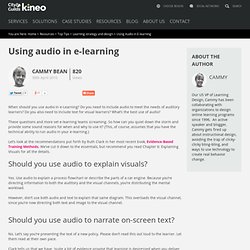
Do you need to include audio to meet the needs of auditory learners? Do you also need to include text for visual learners? What’s the best use of audio? These questions and more set e-learning teams screaming. So how can you quiet down the storm and provide some sound reasons for when and why to use it? Let’s look at the recommendations put forth by Ruth Clark in her most recent book, Evidence-Based Training Methods. E-learning narration + elearning audio + voiceovers for online training, computer based training / CBT , and multimedia : eLearningAudio.com.
Why audio for elearning? « e3Learning Engage Blog. There’s been a lot of noise in the online training industry about whether or not audio can contribute to a valuable learning experience.

Some believe narration improves accessibility for those who have difficultly reading or have a preference for an auditory learning style. Others argue that delivering full narration over text can be overwhelming for the learning experience. What do the users say? Our learner feedback shows a clear split between those who like audio and those who dislike audio as it limits their ability to read at their own pace. So how can you meet the needs of both learners in the one package? Using Images and Audio in eLearning. It’s now 2011 and every eLearning designer knows that creating a page full of text is not effective design.
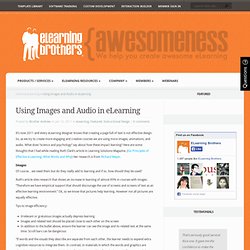
How to... write and use audio in eLearning. Have you ever noticed that when you are reading it is not easy to ‘tune in’ when someone speaks to you?

You might think “why would you even try to read and listen at the same time” or “surely it’s rude to interrupt someone when they are reading”, but the point here is that this expectation is placed on many who sit through an e-learning course. Struggling to listen to the spoken word whilst reading on-screen text is not unusual. Most people will find if difficult to “multi-task” in this regard. They will in fact mentally switch to do one thing or the other i.e. they listen to the audio or read the text. If the audio is an exact mirror of the text, this is not particularly easy either as “We read and hear at different speeds”. According to Cognitive Theory and the Design of Multimedia Instruction by R Richard E. So how can use audio effectively and avoid information overload. Using Audio in eLearning. Audio & Video Tips. Uses for Audio in eLearning. By Shelley A.
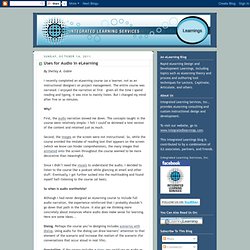
Gable I recently completed an eLearning course (as a learner, not as an instructional designer) on project management. The entire course was narrated. I enjoyed the narration at first – given all the time I spend reading and typing, it was nice to mainly listen. But I changed my mind after five or so minutes. Why? First, the audio narration slowed me down. 10 Tips for Capturing e-Learning Audio. By Al Lemieux, Senior Designer, SyberWorks, Inc.

La sonification des interfaces homme/machine (1ère partie) « Le Chant du Signe. Sound Designers .Org - Le son qui a du sens. Intermittent est l’assistant personnel dédié aux intermittents du spectacle.
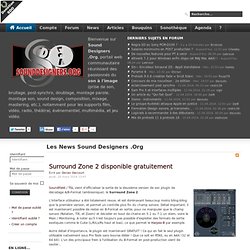
AUDIO PIGMENT,identité sonore,création musicale,soundesign,voix off,studio enregistrement. The Philosophy of Music. 1.

What Is Music? 1.1 Beyond ‘Pure’ Music In most of this entry, the discussion focuses on ‘pure’ or ‘absolute’ music – instrumental music that has no accompanying non-musical components. Most of the philosophers whose work is discussed below also put the focus here, and there are three reasons to do so. The first is that pure music often presents the most difficult philosophical problems. Given the global prevalence of rock music, broadly construed, it is plausible that song is the most common kind of music listened to in the contemporary world. 1.2 The Definition of ‘Music’ Explications of the concept of music usually begin with the idea that music is organized sound. The main problem with the first kind of condition is that every sound seems capable of being included in a musical performance, and thus characterizing the essentially musical features of sounds seems hopeless.
Having discussed additional conditions, it's worth returning to the basic idea of ‘organized sound’. 2. 3. 4. Music as Language. Music as Language Links to Other Pages and Places Try to consider music from the viewpoint of a linguist.
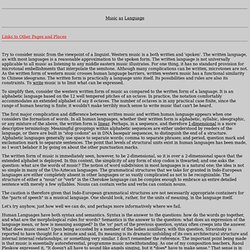
Western music is a both written and 'spoken'. The written language, as with most languages is a reasonable approximation to the spoken form. The written language is not universally applicable to all music as listening to any middle eastern music illustrates. To simplify then, consider the western written form of music as compared to the written form of a language. The first major complication and difference between written music and written human language appears when one considers the formation of words.
The written form of music is immediately seen, however, to be 2-dimensional, so it is over a 2-dimensional space that the extended alphabet is deployed. The caution is therefore given that Indo-European grammatical structures are not necessarily appropriate containers for the "parts of speech" in a musical language. Human Languages have both syntax and semantics. Ed/ITLib Digital Library. Catalogue SUDOC. Interactive Sonification Homepage. The Sonification Handbook. Publications/media/Hermann2008-TAD.pdf. Sonification.de. Sonification. Un article de Wikipédia, l'encyclopédie libre.
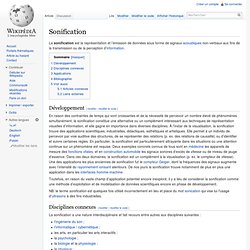
La sonification des interfaces homme/machine (2ème partie : typologie des signaux sonores) « Le Chant du Signe. Dans ce deuxième billet, nous allons évoquer les différentes catégories de signaux sonores les plus courantes dans la sonification des IHM ainsi que les fonctions que chacune d’entre elle est la plus apte à assurer. J’ai choisi de les classer par ordre de signifiance. Autrement dit, nous débuterons par les signaux les plus abstraits et finirons par ceux dont le lien direct ou métaphorique avec la fonction qu’ils sont sensés assurer est le plus fort. Huit thèses sur l'écriture musicale.
Analyse de l'existant. Gestion des médias. Ambiance sonore. Musique. Parole. Mémoire.